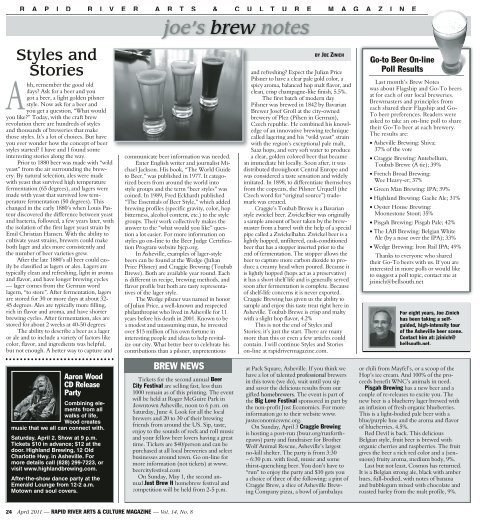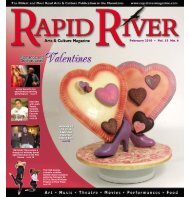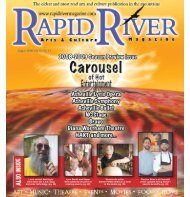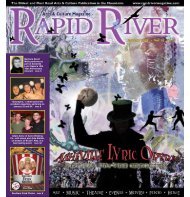JONAS GERARD - Rapid River Magazine
JONAS GERARD - Rapid River Magazine
JONAS GERARD - Rapid River Magazine
You also want an ePaper? Increase the reach of your titles
YUMPU automatically turns print PDFs into web optimized ePapers that Google loves.
R A P I D R I V E R A R T S & C U L T U R E M A G A Z I N E<br />
joe’s brew notes<br />
Styles and<br />
Stories<br />
Ahh, remember the good old<br />
days? Ask for a beer and you<br />
got a beer, a light golden pilsner<br />
style. Now ask for a beer and<br />
you get a question, “What would<br />
you like?” Today, with the craft brew<br />
revolution there are hundreds of styles<br />
and thousands of breweries that make<br />
those styles. It’s a lot of choices. But have<br />
you ever wonder how the concept of beer<br />
styles started? I have and I found some<br />
interesting stories along the way.<br />
Prior to 1880 beer was made with “wild<br />
yeast” from the air surrounding the brewery.<br />
By natural selection, ales were made<br />
with yeast that survived high temperature<br />
fermentation (65 degrees), and lagers were<br />
made with yeast that survived low temperature<br />
fermentation (50 degrees). This<br />
changed in the early 1880’s when Louis Pasteur<br />
discovered the difference between yeast<br />
and bacteria, followed, a few years later, with<br />
the isolation of the first lager yeast strain by<br />
Emil Christian Hansen. With the ability to<br />
cultivate yeast strains, brewers could make<br />
both lager and ales more consistently and<br />
the number of beer varieties grew.<br />
After the late 1880’s all beer could easily<br />
be classified as lagers or ales. Lagers are<br />
typically clean and refreshing, light in aroma<br />
and flavor, and have longer brewing cycles<br />
— lager comes from the German word<br />
lagern, “to store”. After fermentation, lagers<br />
are stored for 30 or more days at about 32-<br />
45 degrees. Ales are typically more filling,<br />
rich in flavor and aroma, and have shorter<br />
brewing cycles. After fermentation, ales are<br />
stored for about 2 weeks at 40-50 degrees.<br />
The ability to describe a beer as a lager<br />
or ale and to include a variety of factors like<br />
color, flavor, and ingredients was helpful,<br />
but not enough. A better way to capture and<br />
Aaron Wood<br />
CD Release<br />
Party<br />
Combining elements<br />
from all<br />
walks of life,<br />
Wood creates<br />
music that we all can connect with.<br />
Saturday, April 2. Show at 9 p.m.<br />
Tickets $10 in advance; $12 at the<br />
door. Highland Brewing, 12 Old<br />
Charlotte Hwy. in Asheville. For<br />
more details call (828) 299-7223, or<br />
visit www.highlandbrewing.com.<br />
After-the-show dance party at the<br />
Emerald Lounge from 12-2 a.m.<br />
Motown and soul covers.<br />
communicate beer information was needed.<br />
Enter English writer and journalist Michael<br />
Jackson. His book, “The World Guide<br />
to Beer,” was published in 1977. It categorized<br />
beers from around the world into<br />
style groups and the term “beer styles” was<br />
coined. In 1989, Fred Eckhardt published<br />
“The Essentials of Beer Style,” which added<br />
brewing profiles (specific gravity, color, hop<br />
bitterness, alcohol content, etc.) to the style<br />
groups. Their work collectively makes the<br />
answer to the “what would you like” question<br />
a lot easier. For more information on<br />
styles go on-line to the Beer Judge Certification<br />
Program website bjcp.org.<br />
In Asheville, examples of lager-style<br />
beers can be found at the Wedge (Julian<br />
Price Pilsner) and Craggie Brewing (Toubab<br />
Brewe). Both are available year round. Each<br />
is different in recipe, brewing methods, and<br />
flavor profile but both are tasty representatives<br />
of the lager style.<br />
The Wedge pilsner was named in honor<br />
of Julian Price, a well-known and respected<br />
philanthropist who lived in Asheville for 11<br />
years before his death in 2001. Known to be<br />
a modest and unassuming man, he invested<br />
over $15 million of his own fortune in<br />
interesting people and ideas to help revitalize<br />
our city. What better beer to celebrate his<br />
contributions than a pilsner, unpretentious<br />
BREW NEWS<br />
Tickets for the second annual Beer<br />
City Festival are selling fast, less than<br />
1000 remain as of this printing. The event<br />
will be held at Roger McGuire Park in<br />
downtown Asheville, noon to 6 p.m. on<br />
Saturday, June 4. Look for all the local<br />
brewers and 20 to 30 of their brewing<br />
friends from around the US. Sip, taste,<br />
enjoy to the sounds of rock and roll music<br />
and your fellow beer lovers having a great<br />
time. Tickets are $40/person and can be<br />
purchased at all local breweries and select<br />
businesses around town. Go on-line for<br />
more information (not tickets) at www.<br />
beercityfestival.com<br />
On Sunday, May 1, the second annual<br />
Just Brew It homebrew festival and<br />
competition will be held from 2-5 p.m.<br />
BY JOE ZINICH<br />
and refreshing? Expect the Julian Price<br />
Pilsner to have a clear pale gold color, a<br />
spicy aroma, balanced hop malt flavor, and<br />
clean, crisp champagne-like finish, 5.5%.<br />
The first batch of modern day<br />
Pilsner was brewed in 1842 by Bavarian<br />
Brewer Josef Groll at the city-owned<br />
brewery of Plez (Pilsen in German),<br />
Czech republic. He combined his knowledge<br />
of an innovative brewing technique<br />
called lagering and his “wild yeast” strain<br />
with the region’s exceptional pale malt,<br />
Saaz hops, and very soft water to produce<br />
a clear, golden colored beer that became<br />
an immediate hit locally. Soon after, it was<br />
distributed throughout Central Europe and<br />
was considered a taste sensation and widely<br />
imitated. In 1898, to differentiate themselves<br />
from the copycats, the Pilsner Urquell (the<br />
Czech word for “original source”) trademark<br />
was created.<br />
Craggie’s Toubab Brewe is a Bavarian<br />
style zwickel beer. Zwickelbier was originally<br />
a sample amount of beer taken by the brewmaster<br />
from a barrel with the help of a special<br />
pipe called a Zwickelhahn. Zwickel beer is a<br />
lightly hopped, unfiltered, cask-conditioned<br />
beer that has a stopper inserted prior to the<br />
end of fermentation. The stopper allows the<br />
beer to capture more carbon dioxide to produce<br />
a creamy head when poured. Because it<br />
is lightly hopped (hops act as a preservative)<br />
it has a short shelf life and is generally served<br />
soon after fermentation is complete. Because<br />
of shelf-life concerns it is never exported.<br />
Craggie Brewing has given us the ability to<br />
sample and enjoy this taste treat right here in<br />
Asheville. Toubab Brewe is crisp and malty<br />
with a slight hop flavor, 4.2%<br />
This is not the end of Styles and<br />
Stories; it’s just the start. There are many<br />
more than this or even a few articles could<br />
contain. I will continue Styles and Stories<br />
on-line at rapidrivermagazine.com.<br />
at Pack Square, Asheville. If you think we<br />
have a lot of talented professional brewers<br />
in this town (we do), wait until you sip<br />
and savor the delicious results from our<br />
gifted homebrewers. The event is part of<br />
the Big Love Festival sponsored in part by<br />
the non-profit Just Economics. For more<br />
information go to their website www.<br />
justeconomicswnc.org.<br />
On Sunday, April 3 Craggie Brewing<br />
is hosting a post-run (bwar.org/runforthepaws)<br />
party and fundraiser for Brother<br />
Wolf Animal Rescue, Asheville’s largest<br />
no-kill shelter. The party is from 3:30<br />
– 6:30 p.m. with food, music and some<br />
thirst-quenching beer. You don’t have to<br />
“run” to enjoy the party and $10 gets you<br />
a choice of three of the following: a pint of<br />
Craggie Brew, a slice of Asheville Brewing<br />
Company pizza, a bowl of jambalaya<br />
Go-to Beer On-line<br />
Poll Results<br />
Last month’s Brew Notes<br />
was about Flagship and Go-To beers<br />
at for each of our local breweries.<br />
Brewmasters and principles from<br />
each shared their Flagship and Go-<br />
To beer preferences. Readers were<br />
asked to take an on-line poll to share<br />
their Go-To beer at each brewery.<br />
The results are:<br />
• Asheville Brewing: Shiva;<br />
37% of the vote<br />
• Craggie Brewing: Antebellum,<br />
Toubab Brewe (A tie); 39%<br />
• French Broad Brewing:<br />
Wee Heavy-er; 37%<br />
• Green Man Brewing: IPA; 39%<br />
• Highland Brewing: Gaelic Ale; 31%<br />
• Oyster House Brewing:<br />
Moonestone Stout; 35%<br />
• Pisgah Brewing: Pisgah Pale; 42%<br />
• The LAB Brewing: Belgian White<br />
Ale (by a nose over the IPA); 33%<br />
• Wedge Brewing: Iron Rail IPA; 49%<br />
Thanks to everyone who shared<br />
their Go-To beers with us. If you are<br />
interested in more polls or would like<br />
to suggest a poll topic, contact me at<br />
jzinich@bellsouth.net<br />
For eight years, Joe Zinich<br />
has been taking a selfguided,<br />
high-intensity tour<br />
of the Asheville beer scene.<br />
Contact him at: jzinich@<br />
bellsouth.net.<br />
or chili from Mayfel’s, or a scoop of the<br />
Hop’s ice cream. And 100% of the proceeds<br />
benefit WNC’s animals in need.<br />
Pisgah Brewing<br />
has a new beer and a<br />
couple of re-releases to excite you. The<br />
new beer is a blueberry lager brewed with<br />
an infusion of fresh organic blueberries.<br />
This is a light-bodied pale beer with a<br />
blue/purple hue and the aroma and flavor<br />
of blueberries, 4.5%.<br />
Red Devil is back. This delicious<br />
Belgian style, fruit beer is brewed with<br />
organic cherries and raspberries. The fruit<br />
gives the beer a rich red color and a (sensuous)<br />
fruity aroma, medium body, 9%.<br />
Last but not least, Cosmos has returned.<br />
It is a Belgian strong ale, black with amber<br />
hues, full-bodied, with notes of banana<br />
and bubblegum mixed with chocolate and<br />
roasted barley from the malt profile, 9%.<br />
24 April 2011 — RAPID RIVER ARTS & CULTURE MAGAZINE — Vol. 14, No. 8

















